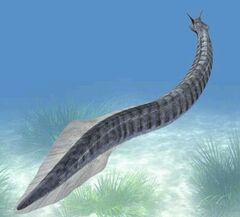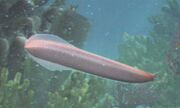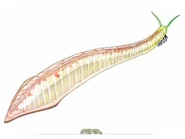(Undo revision 94317 by Toomyx (talk)) |
No edit summary |
||
| (4 intermediate revisions by 3 users not shown) | |||
| Line 14: | Line 14: | ||
| binomial_authority = Walcott, 1911 |
| binomial_authority = Walcott, 1911 |
||
}} |
}} |
||
| − | '''''Pikaia gracilens''''' is an extinct animal known from the Middle [[Cambrian]] Burgess Shale of British Columbia that was the ancestor to all modern-day vertebrates. |
+ | '''''Pikaia gracilens''''' is an extinct animal known from the Middle [[Cambrian]] Burgess Shale of British Columbia that was the ancestor to all modern-day vertebrates. <ref>https://www.nature.com/articles/nature16992</ref> |
| + | |||
| + | ==Description== |
||
| + | |||
==Discovery== |
==Discovery== |
||
| − | In 1911, Charles Walcott and colleagues were digging in the Burgess Shale deposit in British Columbia, when they |
+ | In 1911, Charles Walcott and colleagues were digging in the Burgess Shale deposit in British Columbia, when they came across the fossil of a previously unrecognized creature. [[File:Pikaia.gif|thumb|left|Pikaia Fossil]] Walcott named it ''Pikaia gracilens'', after the area "Pikaia's Peak" where the creature was discovered. At first, no one could tell exactly what genus it belonged in, but Walcott placed as a polychaete worm, since it greatly resembles a modern-day lancelet worm. |
| − | However, reexamination in 1979 by Simon Conway Norris made this creature more significant than previously thought. Norris discovered a very primitive, proto-notochord, which led him to believe '' |
+ | However, reexamination in 1979 by Simon Conway Norris made this creature more significant than previously thought. Norris discovered a very primitive, proto-notochord, which led him to believe ''Pikaia'' was in fact a chordate, and the earliest known ancestor to all vertebrates.[[undefined|thumb|250px|link=File:Pikaia.jpg]] This isn't universially accpeted, though, because its tentacles and cuticle aren't like anything found in modern vertebrates. The notochord is very intriguing, though, and whether or not ''Pikaia'' is a vertebrate ancestor or not is a very controversial debate in the paleontological field. About 114 specimens of this strange vertebrate have been found. The discovery of Pikaia also has lead to a controversy as to how diverse life was back in even the Pre-Cambrian period. <ref>http://bioteaching.wordpress.com/2012/10/16/pikaia-one-of-the-earliest-chordates/</ref> |
| ⚫ | |||
| ⚫ | |||
| − | == |
+ | ==Evolution== |
| − | http://burgess-shale.rom.on.ca/en/fossil-gallery/view-species.php?id=101&ref=i& |
||
| ⚫ | |||
| − | http://en.wikipedia.org/wiki/Pikaia |
||
| + | ''Pikaia'' is a very peculiar-looking creature. At first glance, it'd appear to resemble a lancelet worm, but closer examination revealed that in fact had a notochord, which is a dorsal nerve chord that goes all the way down its back. [[File:Pikaia2.jpg|thumb|left]] This has lead many scientists to believe that this is the blue-print for a backbone, and this would make ''Pikaia'' the earliest known ancestor of all modern vertebrates, from fish to mammals, birds, reptiles, and amphibians. |
||
| ⚫ | [[File:0a1-pikaia-walkcycle.jpg|thumb]] It had a flat body, making it look almost like a species of flatworm. Its tail ended in an almost fin-like structure, and probably allowed it to swim much like an eel. <ref>http://paleobiology.si.edu/burgess/pikaia.html</ref> ''Pikaia'' also had strange, tentacle-like appendages on its "head", and most scientists believe that this eventually lead to gills and fins in fish. Its body also has faint rows of segmented muscle blocks that go all the way down its body. It likely lived in the deep oceans during the Cambrian period and was constantly on the look-out for predators such as ''[[Anomalocaris]]''. <ref>http://dinosaurs.about.com/od/tetrapodsandamphibians/p/pikaia.htm</ref><ref>http://burgess-shale.rom.on.ca/en/fossil-gallery/view-species.php?id=101&ref=i&</ref> |
||
| + | ==In popular culture== |
||
| − | http://dinosaurs.about.com/od/tetrapodsandamphibians/p/pikaia.htm |
||
| + | ==Gallery== |
||
| − | http://paleobiology.si.edu/burgess/pikaia.html |
||
| + | <gallery> |
||
| + | JPI Pikaia.png |
||
| + | </gallery> |
||
| + | ==References== |
||
| − | http://bioteaching.wordpress.com/2012/10/16/pikaia-one-of-the-earliest-chordates/ |
||
| + | <references /> |
||
[[Category:The Burgess Shale]] |
[[Category:The Burgess Shale]] |
||
[[Category:Chordates]] |
[[Category:Chordates]] |
||
| Line 56: | Line 62: | ||
[[Category:Birthdays the Beginning Organisms]] |
[[Category:Birthdays the Beginning Organisms]] |
||
[[Category:Fossil taxa described in 1911]] |
[[Category:Fossil taxa described in 1911]] |
||
| + | [[Category:Carnivores Creatures]] |
||
| + | [[Category:Aquatic life]] |
||
| + | [[Category:Aquatic animals]] |
||
Revision as of 06:08, 25 August 2020
| Pikaia | |
|---|---|

| |
| An artist's illustration of Pikaia gracilens | |
| Scientific classification | |
| Kingdom: | Animalia |
| Phylum: | Chordata |
| Family: | †Pikaiidae |
| Genus: | †Pikaia Walcott, 1911 |
| Species: | †P. gracilens |
| Binomial name | |
| †Pikaia gracilens Walcott, 1911 | |
Pikaia gracilens is an extinct animal known from the Middle Cambrian Burgess Shale of British Columbia that was the ancestor to all modern-day vertebrates. [1]
Description
Discovery
In 1911, Charles Walcott and colleagues were digging in the Burgess Shale deposit in British Columbia, when they came across the fossil of a previously unrecognized creature.

Pikaia Fossil
Walcott named it Pikaia gracilens, after the area "Pikaia's Peak" where the creature was discovered. At first, no one could tell exactly what genus it belonged in, but Walcott placed as a polychaete worm, since it greatly resembles a modern-day lancelet worm.
However, reexamination in 1979 by Simon Conway Norris made this creature more significant than previously thought. Norris discovered a very primitive, proto-notochord, which led him to believe Pikaia was in fact a chordate, and the earliest known ancestor to all vertebrates.thumb|250px|link=File:Pikaia.jpg This isn't universially accpeted, though, because its tentacles and cuticle aren't like anything found in modern vertebrates. The notochord is very intriguing, though, and whether or not Pikaia is a vertebrate ancestor or not is a very controversial debate in the paleontological field. About 114 specimens of this strange vertebrate have been found. The discovery of Pikaia also has lead to a controversy as to how diverse life was back in even the Pre-Cambrian period. [2]
Evolution
Paleobiology
Pikaia is a very peculiar-looking creature. At first glance, it'd appear to resemble a lancelet worm, but closer examination revealed that in fact had a notochord, which is a dorsal nerve chord that goes all the way down its back.

This has lead many scientists to believe that this is the blue-print for a backbone, and this would make Pikaia the earliest known ancestor of all modern vertebrates, from fish to mammals, birds, reptiles, and amphibians.

It had a flat body, making it look almost like a species of flatworm. Its tail ended in an almost fin-like structure, and probably allowed it to swim much like an eel. [3] Pikaia also had strange, tentacle-like appendages on its "head", and most scientists believe that this eventually lead to gills and fins in fish. Its body also has faint rows of segmented muscle blocks that go all the way down its body. It likely lived in the deep oceans during the Cambrian period and was constantly on the look-out for predators such as Anomalocaris. [4][5]
In popular culture
Gallery
References
- ↑ https://www.nature.com/articles/nature16992
- ↑ http://bioteaching.wordpress.com/2012/10/16/pikaia-one-of-the-earliest-chordates/
- ↑ http://paleobiology.si.edu/burgess/pikaia.html
- ↑ http://dinosaurs.about.com/od/tetrapodsandamphibians/p/pikaia.htm
- ↑ http://burgess-shale.rom.on.ca/en/fossil-gallery/view-species.php?id=101&ref=i&
